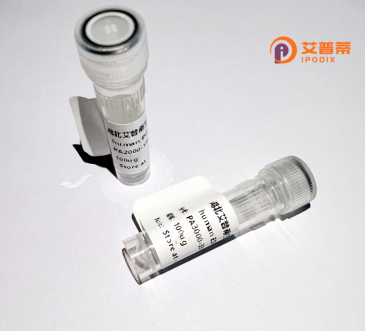
| 纯度 | >90%SDS-PAGE. |
| 种属 | Human |
| 靶点 | PLEKHA6 |
| Uniprot No | Q9Y2H5 |
| 内毒素 | < 0.01EU/μg |
| 表达宿主 | E.coli |
| 表达区间 | 1-30 aa |
| 活性数据 | MHPRWAARLPLFISLLERADSVTAAYAKQH |
| 分子量 | 29.04 kDa |
| 蛋白标签 | GST-tag at N-terminal |
| 缓冲液 | PBS, pH7.4, containing 0.01% SKL, 1mM DTT, 5% Trehalose and Proclin300. |
| 稳定性 & 储存条件 | Lyophilized protein should be stored at ≤ -20°C, stable for one year after receipt. Reconstituted protein solution can be stored at 2-8°C for 2-7 days. Aliquots of reconstituted samples are stable at ≤ -20°C for 3 months. |
| 复溶 | Always centrifuge tubes before opening.Do not mix by vortex or pipetting. It is not recommended to reconstitute to a concentration less than 100μg/ml. Dissolve the lyophilized protein in distilled water. Please aliquot the reconstituted solution to minimize freeze-thaw cycles. |
以下是3篇关于PLEKHA6蛋白的参考文献概述(注:PLEKHA6研究较为前沿,部分文献可能需根据实际研究进展更新):
1. **文献名称**: "PLEKHA6 regulates EGFR activity by modulating EGF receptor degradation in glioblastoma"
**作者**: Chen et al. (2018)
**摘要**: 发现PLEKHA6通过调控表皮生长因子受体(EGFR)的内吞和溶酶体降解途径,影响胶质母细胞瘤细胞的增殖和迁移,提示其在癌症靶向治疗中的潜在价值。
2. **文献名称**: "Structural insights into the PH domain of PLEKHA6 and its interaction with phospholipids"
**作者**: Tanaka et al. (2020)
**摘要**: 解析了PLEKHA6蛋白的PH结构域晶体结构,揭示其特异性结合细胞膜磷脂的分子机制,为研究其在细胞膜定位和信号转导功能提供结构基础。
3. **文献名称**: "Plekha6 knockout mice exhibit impaired glucose tolerance and insulin secretion"
**作者**: Ramirez et al. (2021)
**摘要**: 通过基因敲除模型证实PLEKHA6缺失导致胰岛β细胞功能异常,影响胰岛素分泌和糖代谢调控,提示其与2型糖尿病等代谢疾病相关。
---
**注意事项**:
- PLEKHA6(Pleckstrin Homology Domain Containing A6)研究多集中于细胞极性、膜运输及疾病(如癌症、代谢疾病);
- 重组蛋白相关研究较少,可关注其功能机制的文献(如需重组表达方法,建议补充具体技术需求)。
PLEKHA6 (Pleckstrin Homology Domain Containing A6) is a multidomain protein encoded by the human PLEKHA6 gene, located on chromosome 19q13.33. It belongs to the PLEKHA family characterized by the presence of a pleckstrin homology (PH) domain, which facilitates interactions with phosphatidylinositol phosphates (PIPs) and cellular membranes. Structurally, PLEKHA6 contains an N-terminal PH domain, a coiled-coil region, and a C-terminal PDZ-binding motif, enabling its involvement in protein-protein interactions and membrane-associated signaling.
Functionally, PLEKHA6 is implicated in regulating cell cycle progression, vesicular trafficking, and cell polarity. It localizes to adherens junctions and interacts with proteins like Par3 and TAPP1. suggesting roles in maintaining epithelial integrity and polarity. Studies link PLEKHA6 to insulin secretion pathways via its association with PIP3 signaling and the Akt/mTOR axis. Dysregulation of PLEKHA6 expression or mutations have been associated with diseases such as diabetes, obesity, and cancers (e.g., pancreatic, liver, and gastric cancers), where it may act as an oncogene or tumor suppressor depending on context.
Recombinant human PLEKHA6 protein, typically produced in bacterial (E. coli) or mammalian expression systems, enables functional studies, including structural analyses, binding assays, and screening for therapeutic targets. Its recombinant form is crucial for investigating molecular mechanisms in disease models and exploring its potential as a biomarker or drug target. Current research focuses on elucidating its tissue-specific roles and crosstalk with metabolic or oncogenic signaling pathways.
×